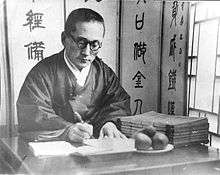Yi Kwang-su
Yi Kwang-su (Korean: 이광수; 1892 – 1950) was a Korean writer and independence and nationalist activist.[1] His pen names were Chunwon and Goju. Yi is most well known for his novel The Heartless, sometimes described as the first Korean novel.[2] Yi Kwangsu was born Yi Bogyeong on February 1, 1892.[3] [4]
Yi Kwang-su | |
|---|---|
 | |
| Born | February 1, 1892 |
| Died | October 25, 1950 (aged 58) |
| Occupation | Novelist |
| Language | Korean |
| Nationality | South Korean |
| Korean name | |
| Hangul | |
| Hanja | |
| Revised Romanization | I Gwangsu |
| McCune–Reischauer | I Kwangsu |
Life

Yi was born in 1892 in Chongju. He was orphaned at about age 10 and grew up with Donghak believers. In 1904, around the time of the Donghak Peasant Revolution, he moved to Seoul in order to avoid the authorities. In 1905 he went to Japan for his education. Upon returning to Korea in 1913, he taught, in Jeongju, at Osan School. He later moved back to Tokyo and became one of the leaders of the anti-colonial student movement.
In 1919, he moved to Shanghai and served in the Korean Provisional Government and became president of The Independent, a newspaper in Shanghai. Yi returned to Korea in 1921 and founded the Alliance for Self-Improvement, established on principles of enlightenment and self-help. From 1923 to 1934, Yi pursued a career in journalism working for several newspapers, including two that survive today, the Dong-a Ilbo and the Chosun Ilbo.
After the war, the Special Committee for the Investigation of Anti-nationalist Activities found Yi guilty of collaboration. In 1950 Yi was captured by the North Korean army and died in Manpo on October 25, most likely of tuberculosis.[5]
Work
Yi was a fiction writer and essayist. His essays originally focused on the need for national consciousness.[6] His fiction was among the first modern fiction in Korea and he is most famous for his novel, The Heartless. The Heartless was a description of the crossroads at which Korea found itself, stranded between tradition and modernity and undergoing conflict between social realities and traditional ideals.[7] His career can be split into thirds. The first period (That of The Heartless), from 1910-19 featured a strong attack on Korea's traditional society and the belief that Korea should adopt a more modern ("western") worldview.[8] From the early 1920s to the 1930s Yi transformed into a dedicated nationalist and published a controversial essay, "On the Remaking of National Consciousness" which advocated a moral overhaul of Korea and blames Koreans for being defeatist.[9] The third period, from the 1930s on, coincides with Yi's conversion to Buddhism and his work consequently becomes quite Buddhist in tone. This was also the period in which, as noted above, Yi became a Japanese collaborator.
Yi's professional judgment could be as fickle as his politics. In one famous case he befriended then abandoned Korean "New Woman" writer Kim Myeong-sun arguably because his own beliefs about modernism had shifted.[10] Yi has also been considered one of the pioneers of queer literature in Korea with the publishing of "Is it Love" in 1909.[11]
Works
- Eorin Huisaeng (어린 희생)
- Mujong (The Heartless) (무정)
- Jaesaeng (재생)
- Sonyunui Biae (소년의 비애)
- Gaechukja (개척자)
- Mumyong (무명)
- The Soil (흙)
- Crown Prince Maui (마의태자)
- Danjongaesa (단종애사)
- Youjong (유정)
- Sarang (사랑)
- Sejo of Joseon (세조대왕)
- Wife of the Revolutionary (혁명가의 아내)
- Aeyokuipiahn (애욕의 피안)
- Halmum (할멈)
- Gashil (가실 嘉實)
- Nauigobaek (나의 고백)
- Wonhyodaesa (원효대사)
- Death of Yichadon (이차돈의 죽음)
- Biography of Yi Sun-sin (전기 이순신)
- Biography of Ahn Changho (전기 안창호)
- Dosan, Ahn Changho
- Stone Pillow (돌베개, Essays)
Translated works in English
- Mujong (The Heartless)
- The Soil
References
- "이광수" biographical PDF available at LTI Korea Library or online at: "Archived copy". Archived from the original on September 21, 2013. Retrieved September 3, 2013.CS1 maint: archived copy as title (link)
- Understanding Korean Literature. Kim Hunggyu M. E. Sharpe. Armonk, NY. 1997.
- Korean Literature Translation Institute Database http://www.klti.or.kr/AuthorApp?mode=6010&aiNum=12337
- Neuhaus, Dolf-Alexander (2017). ""Awakening Asia": Korean Student Activists in Japan, The Asia Kunglun, and Asian Solidarity, 1910–1923". Cross-Currents: East Asian History and Culture Review. 6 (2): 608–638. doi:10.1353/ach.2017.0021.
- Korean Literature Translation Institute Database http://www.klti.or.kr/AuthorApp?mode=6010&aiNum=12337
- A History of Korean Literature. Peter H. Lee, Cambridge University Press. Cambridge, England.2003
- Understanding Korean Literature. Kim Hunggyu M. E. Sharpe. Armonk, NY. 1997. P. 118
- Korean Literature Translation Institute Database http://www.klti.or.kr/AuthorApp?mode=6010&aiNum=12337
- Korean Literature Translation Institute Database http://www.klti.or.kr/AuthorApp?mode=6010&aiNum=12337
- KTLIT http://www.ktlit.com/korean-literature/women-and-korean-literature-short-article-by-helen-koh
- admin (2012-09-25). "Queering Korean Literature: Author and Activist Yi Gwang-su - the3WM". thethreewisemonkeys.com. Retrieved 2018-05-12.
External links
| Wikimedia Commons has media related to Yi Kwang-su. |
- Yi Gwang-su: Pro-Japanese? (in English)
- Queering Korean Literature: Author and Activist Yi Gwang-su (in English)
- 북한, 6·25 납북인사 묘역 첫 공개 조선일보 2005.07.26
- 춘원 이광수의 `무정 영문판 출판 조선일보 2005.10.23
- 춘원 이광수는 어떻게 친일로 변절했나 오마이뉴스 2005.09.18
- [책마을] 친일과 애국 사이… 춘원의 두얼굴 조선일보 2000.01.10